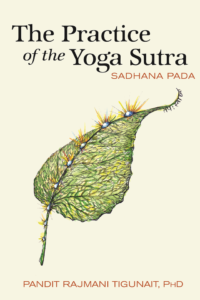According to yoga, our true inner nature is the light of pure consciousness. This light of pure consciousness exists everywhere. Our body and mind cannot exist without it. The sages say this light is most concentrated in the area of the anahata chakra, the space of the heart. This concentrated light is the essence of pure wisdom, pure love, pure compassion, unalloyed joy, and abiding intelligence.
Our true inner nature is the light of pure consciousness.
Often we feel that we do not experience this light in our life, or if we do, it comes and goes sporadically, seeming to be quite random. The reason is that our worldly thoughts and concerns create a haze that covers this light within us, and this haze is thicker at some times than at others. But there are ways, according to the Yoga Sutra, that we can capture this experience and maintain a level of inner joy and light even while living in the world—working, engaging in relationships, seeking fulfillment. To access this light, we need to start from where we are in our own body and mind.
Working with the Body
The key is to keep our body strong and resilient and our mind free from anxiety, worry, anger, grief, and doubt. To do this, it is helpful to understand the relationship between our body, heart, and mind. The body supports the healthy functioning of the organs, including the brain and the heart. If our physical functioning is compromised, the movement of prana can also be compromised, or even decreased. We may not be aware of it, but slowly over time it drains us of our will, our determination, our body’s intelligence, our joy, and our vitality. To keep a healthy body, the first foundational step is asana practice.
Through asana, we are able to reduce back pain, alleviate some of the aches in our joints, decrease our anxiety, lower our blood pressure, combat heart disease, and in many other substantial ways strengthen the functioning of our body. This is a necessary step that helps us relieve mental and emotional pain and enhance the quality of our life.

Working with the Mind
Then we can look at the mind. As we know from our practice, the body and mind are intimately connected. When we do our practice, our mind is more at peace. When we don’t, we are more apt to be reactive and doubtful about our lives and ourselves. We get stuck with our senses moving outward, catching hold of any thread of entertainment or relief or external habit we have cultivated. We lose our connection to our inner light.
So, after establishing a stable and comfortable body, relatively free of discomfort or disease, we need to calm the mind. This second foundational step is vital to our connection to the deeper regions in our heart. If the mind is wandering here and there, worried about this and that, the light and joy of the heart are quite difficult to access. This kind of mind does not have the ability to experience the sublime aspects of vishoka, joy that is untouched by sorrow or angst, and jyotishmati, the supreme light of the heart. Without a quiet mind, guided by inward-moving prana, we miss out on this joy and light—manifestations of the ever-flowing grace within us.
Without a quiet mind, we miss out on the joy and light within us.
Practices for the Heart
There are asana practices that specifically strengthen and stabilize the body and the heart area and turn us inward, such as mula bandha, ashvini mudra, agni sara, and virabhadrasana 1 and 3, to name a few. Through these specific postures, we can increase access to the four gifts that come with a body: rupa (beauty); lavanya (tastefulness, charm); bala (vigor and vitality); and vajra-samhananatva (inner healing power) (YS 3:46).
Once there is ease and stability in the body, you can add specific breathing and pranayama practices, such as sandbag breathing, diaphragmatic breathing, samikarana pranayama and nadi shodhana (alternate nostril) pranayama to turn the mind peacefully inward in preparation for meditation. With a calm mind, you will be able to access the deeper stillness of the heart, where you can rest in your true nature of unobstructed joy and light.

